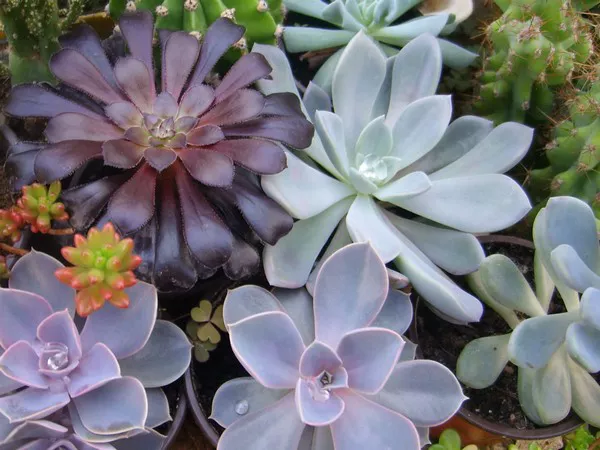Succulents, with their diverse shapes and vibrant hues, have gained immense popularity as indoor and outdoor plants. While renowned for their resilience and ability to thrive in arid conditions, the amount of light they receive plays a crucial role in their growth and overall well-being.
Understanding the Nature of Succulents
Succulents belong to a diverse group of plants known for their ability to store water in their leaves, stems, and roots. This unique adaptation allows them to survive in environments with limited water availability. While succulents can tolerate challenging conditions, including drought, they still require an adequate amount of light to carry out essential processes such as photosynthesis. Understanding the natural habitats of succulents, which often include arid regions with abundant sunlight, provides valuable insights into their light requirements.
Sun-Loving Succulents
The majority of succulents are classified as sun-loving plants, meaning they thrive in environments with abundant sunlight. These succulents, including popular varieties like Echeveria, Sedum, and Aloe, prefer to bask in direct sunlight for several hours each day. Placing sun-loving succulents in locations with ample sunlight exposure ensures that they receive the energy necessary for robust growth, vibrant coloration, and the development of intricate leaf patterns.
Indoor Succulents and Light Considerations
While succulents are often associated with sunny outdoor spaces, many enthusiasts also cultivate these plants indoors. Indoor succulents require careful consideration of light conditions to replicate the natural environment they thrive in. Placing succulents near windows that receive bright, indirect sunlight is ideal for indoor cultivation. Additionally, rotating succulents periodically ensures even light exposure on all sides, preventing them from leaning towards the light source.
Types of Light for Succulents
Succulents can adapt to different types of light, but not all light sources are equally beneficial. The three primary types of light are direct sunlight, indirect sunlight, and artificial light. Direct sunlight, especially in the morning or late afternoon, is suitable for sun-loving succulents. Indirect sunlight, often found in bright, filtered conditions, is well-suited for more delicate succulent varieties. When using artificial light, such as grow lights, it’s essential to choose the right spectrum—typically a combination of blue and red light—to support the different stages of succulent growth.
Signs of Inadequate Light
Succulents provide visual cues when they are not receiving enough light. Common signs of inadequate light include elongated stems (etiolation), stretching towards the light source, and a reduction in vibrant colors. As succulents seek more light, they may appear leggy and less compact. Recognizing these signs allows growers to make necessary adjustments to improve light conditions and ensure the health and aesthetics of their succulents.
Optimal Light Duration for Succulents
Determining the optimal light duration for succulents depends on factors such as the specific species, local climate, and whether the plants are kept indoors or outdoors. In general, outdoor succulents benefit from at least six hours of direct sunlight per day. Indoor succulents can thrive with slightly less, around four to six hours of bright, indirect sunlight. Monitoring the response of succulents to their light environment provides valuable insights into whether adjustments are needed.
Protecting Succulents from Intense Sunlight
While many succulents thrive in full sun, prolonged exposure to intense sunlight, especially during the hottest part of the day, can lead to sunburn and damage. To protect succulents from harsh sunlight, consider providing filtered shade, using shade cloth, or relocating them to spots with dappled sunlight. This approach ensures that succulents receive the light they need without risking sun damage.
Adjusting Light Conditions in Different Seasons
Succulents may experience variations in light conditions due to seasonal changes. In regions with distinct seasons, the angle and intensity of sunlight can shift throughout the year. Growers should be attentive to these changes and adjust the placement of their succulents accordingly. During the winter months, when sunlight may be less abundant, providing supplemental artificial light can help sustain optimal growth.
Importance of Well-Draining Soil
Beyond light considerations, the type of soil in which succulents are planted also influences their overall health. Well-draining soil is essential for preventing waterlogged conditions, which can lead to root rot. Combining appropriate light conditions with well-draining soil creates an optimal environment for succulents, allowing them to thrive and showcase their unique characteristics.
Observation and Flexibility
Successful cultivation of succulents involves a combination of knowledge, observation, and flexibility. Each succulent species may have specific light preferences, and individual plants within a species may exhibit variations in their response to light. Growers should observe their succulents regularly, noting any changes in appearance and adjusting light conditions accordingly. Flexibility in responding to the unique needs of each succulent contributes to a thriving and visually appealing collection.
Conclusion
Succulents, with their remarkable adaptations to arid environments, captivate plant enthusiasts worldwide. Achieving optimal growth and aesthetics in succulents involves a delicate balance of providing the right amount and type of light. Whether cultivating sun-loving varieties outdoors or carefully placing indoor succulents near well-lit windows, understanding the intricacies of light requirements is essential. By applying these insights and remaining attentive to the unique characteristics of each succulent, growers can create environments that encourage flourishing, vibrant, and resilient succulent displays.


